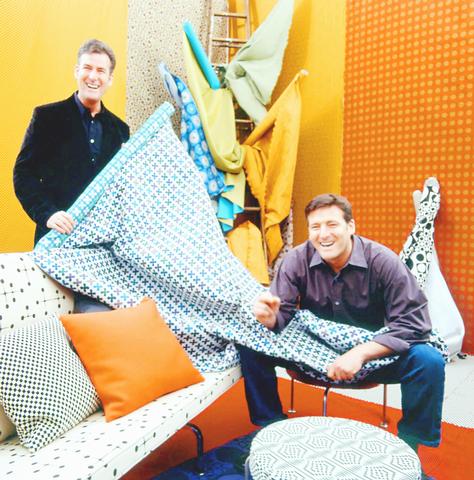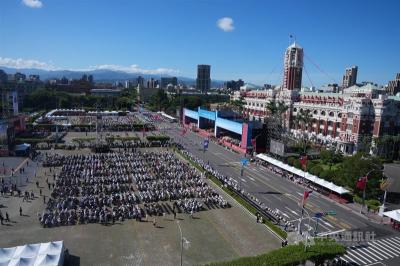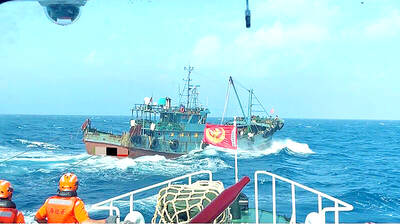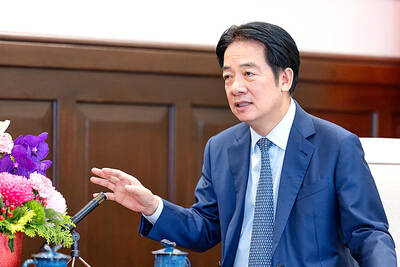While the plot thickeners are all in the mix -- two ambitious brothers, a multimillion-dollar family business that began with the proverbial pushcart, an indomitable father -- the Maharam story is no made-for-television melodrama.
But it is a tale about the warp and weave of the design-crazed '90s and about how those brothers managed to make office upholstery something to rave about -- and even to bring into the home.

PHOTO: NY TIMES
Maharam is a century-old textile company transformed over the last four years from a dowdy, mass-market operation known for fabrics sturdy enough to withstand a blowtorch into a company throwing off sparks. Last month the Cooper-Hewitt National Design Museum announced that Maharam is a finalist in its annual National Design Awards, which will be presented on Wednesday.
Having long outgrown its 1950s motto "House of Service," the Maharam name is now associated with some of the most progressive designs in the textile industry, including a rubberlike upholstery spun from the same mills used to make Prada's knapsacks and commissions to hot Dutch artists. Maharam has chalked up insider points as well by reintroducing patterns by design legends like Charles and Ray Eames, Alexander Girard, Verner Panton and Gio Ponti.
"They made a complete turnaround to become a real front-runner," said Jack Lenor Larsen, the modern textile designer and eminence grise of the industry, speaking of the Maharam brothers, Michael and Stephen, the fourth generation to run the company.
In an intensely competitive half-billion-dollar industry that sells contract textiles -- fabrics prized less for their looks than for their durability and flame resistance -- Maharam has played the panache card, and in the process, doubled profits to US$100 million over the last four years, said Stephen Maharam, at 39 the younger of the brothers.
"These are times when the difference between most designs is not the good versus the bad, but good versus great," said Michael Maharam, 42, the more outspoken of the brothers. Both are handsome in a wide-eyed Buzz Lightyear kind of way. "But there's too much splashy, flashy fluff out there," he added. "We're trying to do textiles that are clean, beautiful, perfect."
This swatch-world makeover began in the late 1960s with two brothers playing in the storage basement of an old Times Square warehouse. Their toys were Styrofoam balls, retractable extension rods and Mylar sheets, castoffs from their grandfather's garment-district business; he made stage curtains for theaters and panels for department store seasonal displays.
During their childhood, their father, Donald Maharam, had steered the company away from gold lame curtains to tap into a huge new market for hospital curtains, cubicle panel fabrics and grill cloths for RCA's first 10-inch color television cabinets. "It was not a company about creativity," Michael Maharam said. "It was about selling as many zillions of yards as possible."
The unglamorous held no appeal for Michael Maharam, who spent his 20s in self-discovery, working as, among other things, a maintenance man servicing celebrity aquariums in Beverly Hills. "Candy Spelling always wanted new fish brought in to match the color themes of her parties," he recalled of the movie mogul's wife. In San Francisco, he met Uschi Weismuller, a graphic designer from Switzerland, whom he married in 1997.
He returned briefly to Maharam in 1990, but left for travel abroad in protest of the hidebound managers who had assumed control of the company as his father phased himself into retirement.
All the while, Stephen Maharam worked steadfastly for the company, absorbing his father's strict sales technique. "First, nothing is ever `nice,"' he said. "My father always insisted that you search for better words, like gossamer or luxurious." After 12 years of rising at 5:30am and wining and dining clients five nights a week, a frustrated Stephen Maharam gave notice in 1997.
In response, Donald Maharam made a proposition to his sons: He'd buy out the company shares controlled by the two remaining partners and back the two boys if they would take command.
With no experience running anything like a company, much less one with 350 employees and 30 showrooms, the brothers did hesitate -- but not for long. "We were on a ski lift in Switzerland" Stephen Maharam recalled, "and we decided to give it a shot."
Michael would take over image, design, marketing; Stephen would run the show.
The timing couldn't have been better. By the mid-1990s, new design was the currency of the hip culture and the brothers began repositioning the company with a vengeance. Michael was forceful in demanding that the new Maharam have a fashion-inspired edge. No more sedated maroons and navy blue to muddy up the conference room. Maharam would sell the same palette that was cat-walking down the runways in Milan.
The first line under Michael Maharam's direction featured a full run of Gucci-compatible materials with a cling fit called Ready to Wear, about US$45 a yard. Another new line, Action Fabrics, US$35 a yard, is made of a duotone synthetic mesh textile in Nike-cool colors like lime on aqua, and orange on red. According to Mary Murphy, Maharam's director of design, they were the upholstery of choice for dot-com offices, where the work station was, for a while at least, the vocational equivalent of an extreme sport.
With their on-the-pulse designs -- and lofty press release references to the Cranbrook Academy of Art in Michigan and Hans Hoffman, the Abstract Expressionist -- Maharam made design savants tingle.
"I was never interested in contract textiles before I talked to Michael," said Murray Moss, who showcases Maharam's boldest bolts at his store, Moss, in SoHo. "They showed that contract doesn't have to be brown, washable and indestructible. What made it more interesting for me was that they also understand the link between fabric, pattern, graphics and furniture."
Michael Maharam, with his Yohji Yamamoto black shirt and vaudeville smile, is the public persona of Maharam. He likes to lunch. Even before the breadbasket arrives, he has run down his history of early rebellion, wanderlust and odd collecting habits (brass mouthpieces and Italian fishing lures). A favorite topic is his professional courtship of the daughters and widows of famous designers.
Lucia Eames, the daughter of Charles and Ray, invited him into her parents house to inspect their favorite colors in situ. On a visit to Milan, he met Lisa Ponti, daughter of Gio, who ripped off a strip of an original 70-year-old pattern (Lovers at the Window, US$120 to the trade) and handed it to him for reproduction.
While much of the credit for the Maharam revival belongs to the fabrics themselves, a tightly orchestrated image plays a part as well. In 1998, Michael Maharam's wife, Weismuller, took over the graphics, designing everything from fax cover sheets to construction showroom signage. The look has the clear simplicity of classic Modern, with a Scandinavian brightness. The Manhattan offices near Gramercy Park were redesigned by Fernlund & Logan, architects of the offices of the avant-garde journal Visionaire. Sample books in satellite showrooms are presented in color-coded cubic wall units a la Donald Judd.
"Employees were told to put away the beanie babies," Michael Maharam said, "and there would be no more handwritten labels."
Everything would be graphically clean, "even pharmaceutical," he added. Commissions went out to designer darlings, like Hella Jongerius, the Dutch designer, and Bruce Mau, the Canadian graphic artist. In addition to the archival reintroductions that endowed instant seriousness of purpose, Maharam is also developing a stringently monitored environmental line.
In keeping with the dictate that "nice" won't suffice, the Maharam sales force now attends monthly lectures by design cognoscenti like Aaron Betsky, a former curator at the San Francisco Museum of Modern Art. "I want the truck drivers in the warehouse to be able to talk about Gio Ponti," Michael Maharam said.
Competitors admire the way Maharam has inflated its image. "It's rare to find a company that has managed to inject the emotional and the inspirational into their project while still keeping an eye on efficiency and fulfillment," said Greg Parsons, the president of Herman Miller Red, a company that has collaborated with Maharam.
While figures are not available, the contract industry is beginning to slow down along with the rest of the economy. Maharam, Stephen Maharam says, is flush enough to undertake a complete overhaul of its Hauppauge, New York, warehouse.

The Republic of China (ROC) is celebrating its 114th Double Ten National Day today, featuring military parades and a variety of performances and speeches in front of the Presidential Office in Taipei. The Taiwan Taiko Association opened the celebrations with a 100-drummer performance, including young percussionists. As per tradition, an air force Mirage 2000 fighter jet flew over the Presidential Office as a part of the performance. The Honor Guards of the ROC and its marching band also heralded in a military parade. Students from Taichung's Shin Min High School then followed with a colorful performance using floral imagery to represent Taiwan's alternate name

COGNITIVE WARFARE: Chinese fishing boats transmitting fake identification signals are meant to test Taiwan’s responses to different kinds of perceived incursions, a report said Chinese vessels are transmitting fake signals in Taiwan’s waters as a form of cognitive warfare, testing Taipei’s responses to various types of incursions, a report by the Institute for the Study of War said on Friday. Several Chinese fishing vessels transmitted fake automatic identification system (AIS) signals in Taiwan’s waters last month, with one mimicking a Russian warship and another impersonating a Chinese law enforcement vessel, the report said. Citing data from Starboard Maritime Intelligence, the report said that throughout August and last month, the Chinese fishing boat Minshiyu 06718 (閩獅漁06718) sailed through the Taiwan Strait while intermittently transmitting its own AIS

CHINESE INFILTRATION: Medical logistics is a lifeline during wartime and the reported CCP links of a major logistics company present a national security threat, an expert said The government would bolster its security check system to prevent China from infiltrating the nation’s medical cold chain, a national security official said yesterday. The official, who wished to stay anonymous, made the remarks after the Chinese-language magazine Mirror Media (鏡周刊) reported that Pharma Logistics (嘉里醫藥物流) is in charge of the medical logistics of about half of the nation’s major hospitals, including National Taiwan University Hospital and Taipei Veterans General Hospital. The company’s parent, Kerry TJ Logistics Co (嘉里大榮物流), is associated with the National Committee of the Chinese People’s Political Consultative Conference (CPPCC) and the Chinese People’s Liberation Army (PLA), the

COVETED PRIZE: The US president would be a peace prize laureate should he persuade Xi Jinping to abandon military aggression against Taiwan, William Lai said US President Donald Trump should get the Nobel Peace Prize should he be able to convince Chinese President Xi Jinping (習近平) to abandon the use of force against Taiwan, President William Lai (賴清德) told a conservative US radio show and podcast in an interview. The US is Taiwan’s most important international backer, despite the absence of formal ties, but since Trump took office earlier this year he has not announced any new arms sales to the nation. Trump could meet Xi at the APEC summit in South Korea on Oct. 31 and Nov. 1. Lai, speaking on The Clay Travis and Buck Sexton